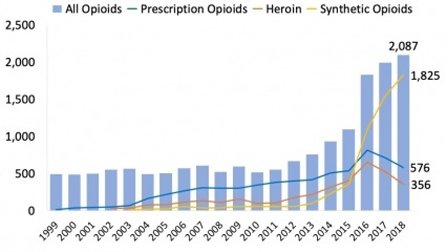A Growing Drug Problem in Maryland Raises Concern

Headlines across America often read something like this: "Drug Overdoses on the Decline!" That is a dangerous message to promote. For example, while national fatal overdoses did drop 4 percent in 2018, 128 people still die every day from overdoses. About 67,000 people still lost their lives from overdoses in 2018. In fact, many states saw an increase in drug deaths in 2018, not a decrease.
We're not out of this problem until we’re all out of it. As long as addiction is still a problem (with tens of millions addicted and tens of thousands dying from overdoses every year), it’s unwise to celebrate a slight drop in overdose deaths one year to the next. It sends the wrong message, as it makes people think they should rejoice when really they should be working even harder to tackle the drug problem.
Case in point, Maryland is fast becoming a new epicenter for opiate deaths, with far more drug deaths recorded in 2018 than in any other year since such recording began.
US and Maryland Drug Crises - A Snapshot
A reliable way to examine the severity of a drug problem in any given state is to explore the statistics of that state's drug problem and compare them against the national averages. Following is some data on Maryland and the US as a whole, particularly as pertains to drug overdose deaths:

There were 67,367 overdose deaths in the United States in 2018, 4.1 percent fewer deaths than in 2017. That comes out to about 21 deaths per 100,000 people living in the US
Maryland had the third-highest concentration of drug overdoses with about 2,300 people dying in this state from drug overdoses in 2018. That comes out to about 37 deaths per 100,000 people, almost twice the national average. As far as the top killer in the region, opioids cause the most drug-related deaths in this state. Opioids account for about 70 percent of all drug deaths nationwide, they account for more than 90 percent of all Maryland drug deaths. Many experts believe that Maryland was one of the states that experienced a surge in drug deaths in 2018 because of the state's severe opioid problem.
Maryland's opioid problem can also be narrowed down to very specific kinds of opiates. For example, Maryland's prescription opiate deaths and heroin deaths have been declining since 2017, but overdoses from synthetic opioids such as fentanyl have skyrocketed in recent years.
Opioid deaths are still soaring even despite the fact that opioid prescribing has dropped off in Maryland. Physicians are now writing 45 opioid prescriptions for every 100 persons, compared to a national average of 51 prescriptions for every 100 persons. But as prescription painkiller prescribing dropped, fentanyl and other illicit synthetic opioids spread like wildfire across the state. Fentanyl and fentanyl analogs were present in almost 90 percent of all opioid-related deaths in Maryland in 2018.

And it's not just the addicts themselves who are suffering. The opioid crisis in Maryland is also having a harsh effect on new births, as evidenced by soaring numbers of Neonatal Abstinence Syndrome (NAS) cases. For example, the rate of NAS births in Maryland is at about 14.3 cases per 1,000 births, compared to the national average of seven cases per 1,000 births (less than half Maryland's figure).
The opiate problem in Maryland is also leading to HIV and Hepatitis C transmissions in Maryland. Roughly one out of every five HIV cases in Maryland can be traced back to use of intravenous drugs. Nationally, about 16 percent of HIV cases can be traced back to intravenous drug use. Maryland has a significantly higher HIV per capita rate than the national average. Since opioids are often injected (and needles are often shared during IV drug use), the growing problem of HIV and Hepatitis C can often be traced back to opioid use.
Maryland's Fatal Drug Problem Surges While Some States Celebrate a Downward Trend in National Overdoses
The above data is grim but should be heard and should be repeated. When major media centers announce headlines that say, "Drug Overdoses On Their Way Down," they are neglecting states like Maryland where drug addiction is still a genuine problem, and where it is a steadily growing problem. While drug deaths peaked in the United States in 2017 and then fell slightly in 2018, the overdose epidemic in Maryland has risen every year since 2010.
For Maryland to overcome its fatal drug crisis, those who are addicted must seek help at qualified drug and alcohol treatment centers.
Addiction Treatment - The Solution to Reducing Drug Overdose Deaths
Addiction does not go away on its own. The longer one uses drugs, the worse their drug problem becomes. Those who use drugs and alcohol find themselves pulled further and further into the vicious cycle of addiction, further down the dwindling spiral of substance abuse.
Thankfully, drug and alcohol treatment centers can halt the addiction decline, giving recovering addicts a chance to experience a life that is free of the potentially fatal crisis that is addiction. If you know someone struggling with an addiction to drugs and alcohol, please do not wait until it is too late. Call Narconon today and take the first step towards getting your loved one into treatment.
Sources:
- https://www.drugabuse.gov/drug-topics/opioids/opioid-overdose-crisis
- https://www.drugabuse.gov/drug-topics/opioids/opioid-summaries-by-state/maryland-opioid-involved-deaths-related-harms
- https://www.cdc.gov/nchs/products/databriefs/db356.htm
- https://www.samhsa.gov/data/sites/default/files/Maryland_BHBarometer_Volume_4.pdf
- https://www.drugabuse.gov/drug-topics/trends-statistics/overdose-death-rates
Reviewed and Edited by Claire Pinelli, ICAADC, CCS, LADC, RAS, MCAP


 ®
®